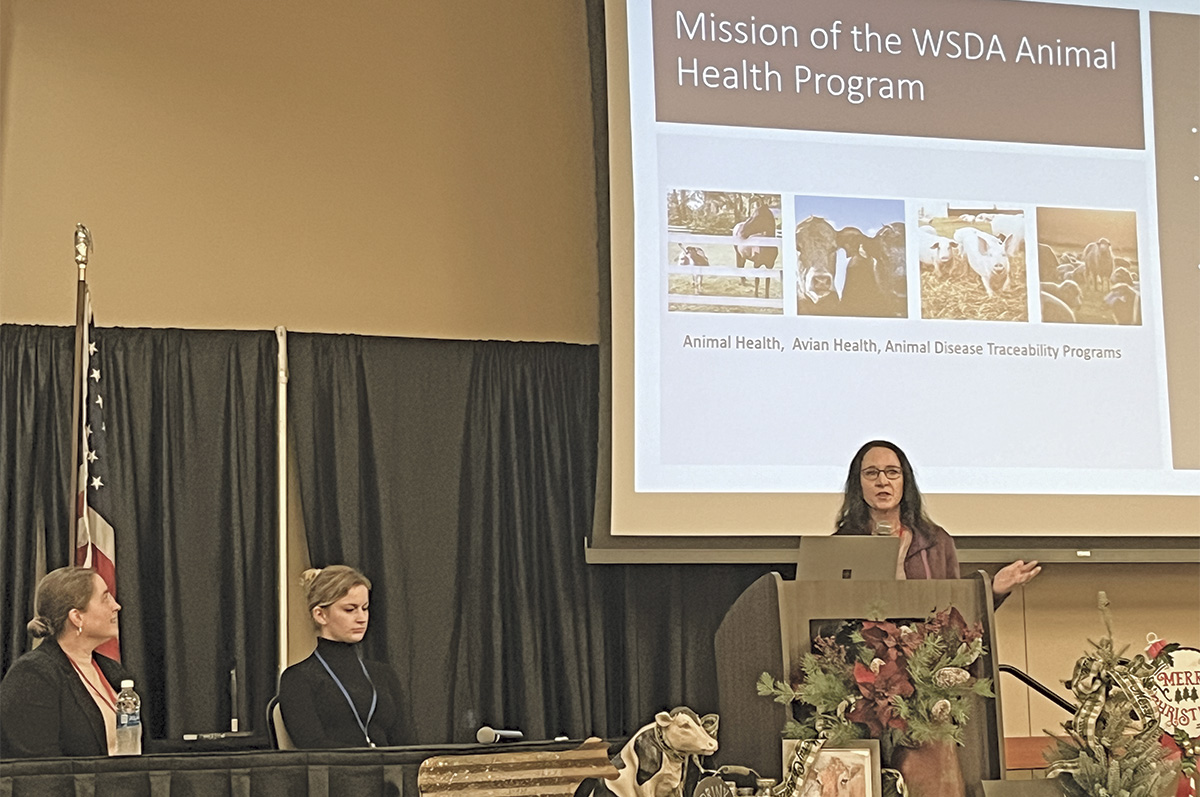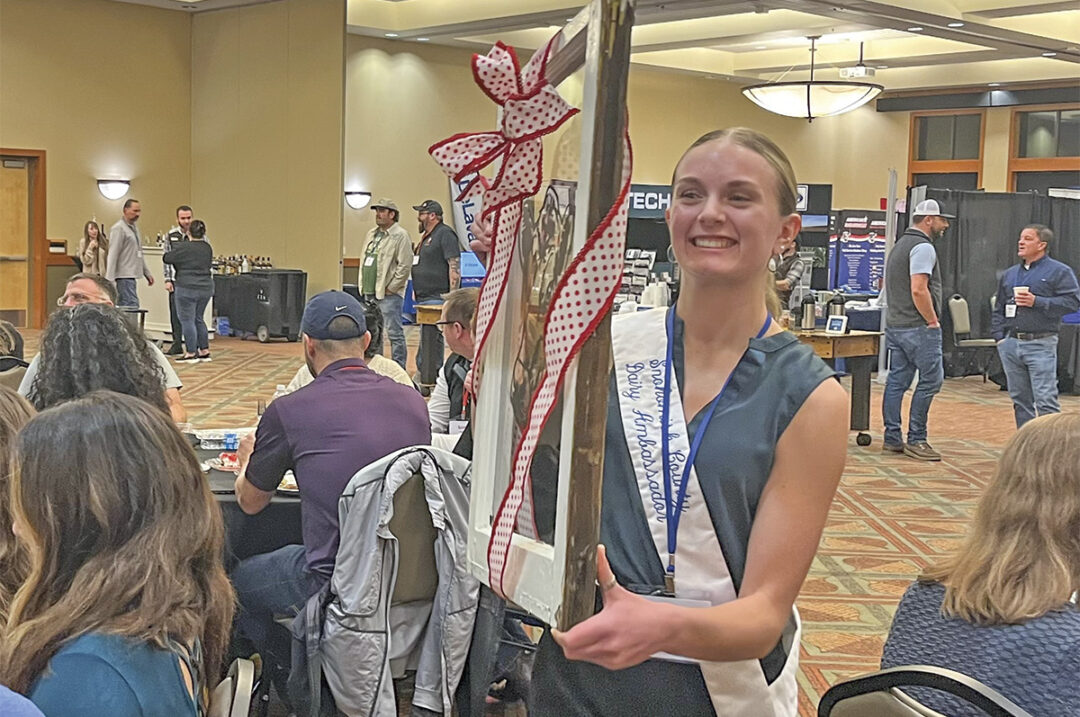The Washington Dairy Conference, held Dec. 4-6 in Chehalis, Washington, featured hot topics facing the state’s dairy industry, a chance to meet with state agricultural leaders, and ample networking time for attendees and trade show exhibitors.
In addition to the sessions presented by industry organizations, representatives from various state and federal agencies highlighted available funding opportunities for producers, along with other program updates. Two breakout sessions offered additional information about Natural Resources Conservation Service (NRCS) programs and carbon market projects.
Hot topics for dairy in the Evergreen State
Washington State Dairy Federation (WSDF) Executive Director Dan Wood was joined by Jay Gordon, WSDF policy director; Alicia McCarthy, WSDF resources director; and Fred Likkel from Whatcom Family Farmers for a panel discussion covering hot topics facing Washington producers, including water rights, riparian areas, carbon reduction, conservation programs, tax issues, EPA programs, well regulations, carbon tax on farm fuels and upcoming legislation related to waters of the state.
McCarthy also described some of the resources available on the password-protected section of the WSDF website, including a list of fuel distributors honoring the exemption from the carbon tax on farm fuels, conservation programs and grants, and disaster assistance programs.
Updates from the state veterinarian
Among their foreign animal disease (FAD) preparedness efforts, many states are working to protect the continuity of business during an outbreak like foot-and-mouth disease (FMD) through the Secure Milk Supply (SMS) program. The program involves the development of enhanced biosecurity plans that will allow the movement of milk out of the control zone to the processing plant for uninfected operations.
“If you are in a control zone where there is an outbreak, you need to have a biosecurity plan to move product like milk or cattle out of that zone,” Washington State Veterinarian Amber Itle said. “The USDA also requires this to get indemnity payments. So if you want to get paid for your animals, you need to have a biosecurity plan for that as well.”

Washington State Veterinarian Amber Itle (right) shared animal health updates. Tammy Edmonds from Northwest Dairy Association/Darigold (left) and WSU vet student Emma Thrower (center) joined her in speaking about collaborative Secure Milk Supply efforts. Photo by Kimmi Devaney.
Itle said the collaboration between the industry, the state and Washington State University (WSU) has been a great model for developing on-farm SMS plans. Among the participants from WSU’s vet school was vet student Emma Thrower, who worked on the enhanced biosecurity plans during a WSU Veterinary Medicine Extension summer internship focused on biosecurity preparedness and secure food supply initiatives. While working with producers, she also addressed logistical concerns held by dairy managers and their current approaches to on-farm biosecurity.
Some of the categories involved in the plan include the movement of vehicles and equipment, personnel management, animal movement, animal product movement, carcass disposal, manure management, wildlife control and feedstuff handling.
“These biosecurity plans highlight the importance of minimizing movement onto the farm, as well as sanitation of any vehicles, equipment and footwear at all times before entering the operation,” Thrower said. “Creating the premises map is so important because it represents one of the most effective ways to keep FMD away by limiting the exposure of animals to any outside contaminants.”
She said drawing the line of separation and designating the associated access points were among the main challenges when working with producers on these plans. To explain these concepts, Thrower compared a dairy farm to a castle.
“The line of separation is the moat surrounding and protecting the castle from outside invaders,” she said. “We then designate access points – or drawbridges – for where we want to permit entry for any people or vehicles entering the farm.”
Thrower said the three components of the plan producers noted would be most difficult for their operations to implement during an FMD outbreak were 1) cleaning and disinfection, 2) access point monitoring and 3) employee management.
In addition to ongoing FAD preparedness efforts, the Washington State Department of Agriculture (WSDA) and the state veterinarian’s office recently added natural disaster preparedness to the mix.
“Natural disasters like the blizzard [in eastern Washington] in 2019 and the atmospheric river event [in northwest Washington] a few years ago highlighted the need to do more to prepare for these events,” Itle said.
In other news from WSDA, the department is working through the rulemaking process to make brucellosis vaccinations voluntary in Washington state. Itle said many other states have also dropped the requirement.
“We haven’t had any cases in Washington state since 1988, and it’s also been a long time since we’ve seen brucellosis in dairy cattle in other parts of the country,” Itle said. “Our proposal is to make it voluntary, but we want to keep the identification requirement. I don’t think [identification] is a huge problem in the dairy industry. You already rely on identification for management, and we want to keep that because we want to be able to trace animals from birth to harvest. It’s really important for disease containment and eradication. Without that tag, we’re going to put a lot of [operations] under quarantine that don’t need to be in the event of an outbreak.”
Promotion efforts
Checkoff staff from Dairy Farmers of Washington shared their focus areas for the year, which included sustainability, innovation, reputation and exports. Executive Director Steve Seppi provided an overview of the organization’s strategy, while Amanda Molloy, senior director of business development, discussed activations in schools and at retail.
“It’s very important that students have access to a variety of dairy products in the [school] cafeteria and that the experience they have with dairy is positive,” Molloy said. “We’re working on a variety of things to help with that in the cafeteria space in schools, including our grant funding program. This year, we funded everything from smoothie programs to hot chocolate milk to coffee programs, all of which drove increased [student] meal participation. We’re also focusing on the largest school districts where they have the highest percentages of free and reduced meal eligibility [among students]. For example, we’ve worked with Seattle Public Schools to upgrade their milk coolers and add this really great messaging around milk and freshness and nutrition.”
Jackie Madill, the new executive director of the Washington State Beef Commission, the state’s beef checkoff, also shared an overview of their programs.
Following state-specific checkoff updates, Dairy Management Inc.’s Stan Erwine discussed the national dairy checkoff’s approach to helping dairy producers better understand their dairy checkoff investment.
Another organization working on producers’ behalf is Save Family Farming, which is a non-checkoff organization working to protect Washington’s farming community through advocacy, outreach and public education. Unlike the checkoff organizations and WSDF, Save Family Farming can go “toe to toe with activists and others that are creating challenges for the farming community.”
Communications Director Dillon Honcoop began his presentation by asking the audience, “Who feels that Washington state is a safe place to produce milk and to farm?”
“I’m not seeing a lot of hands,” Honcoop observed. “I think we can all point to some specific issues.”
He highlighted water rights adjudication in northwest Washington, Chinook salmon issues, stream buffers and other political and public perception challenges. Honcoop also showcased some of the videos recently produced by Save Family Farming to address these issues.
“We know that the groups who have created some of the challenges that the agricultural community faces have been successful because they appeal to the public’s emotions,” Honcoop said. “We have to be able to do that as well. We must share those stories, and it’s going to have to get emotional. That’s the reality of the situation in Whatcom County and across the state.”





